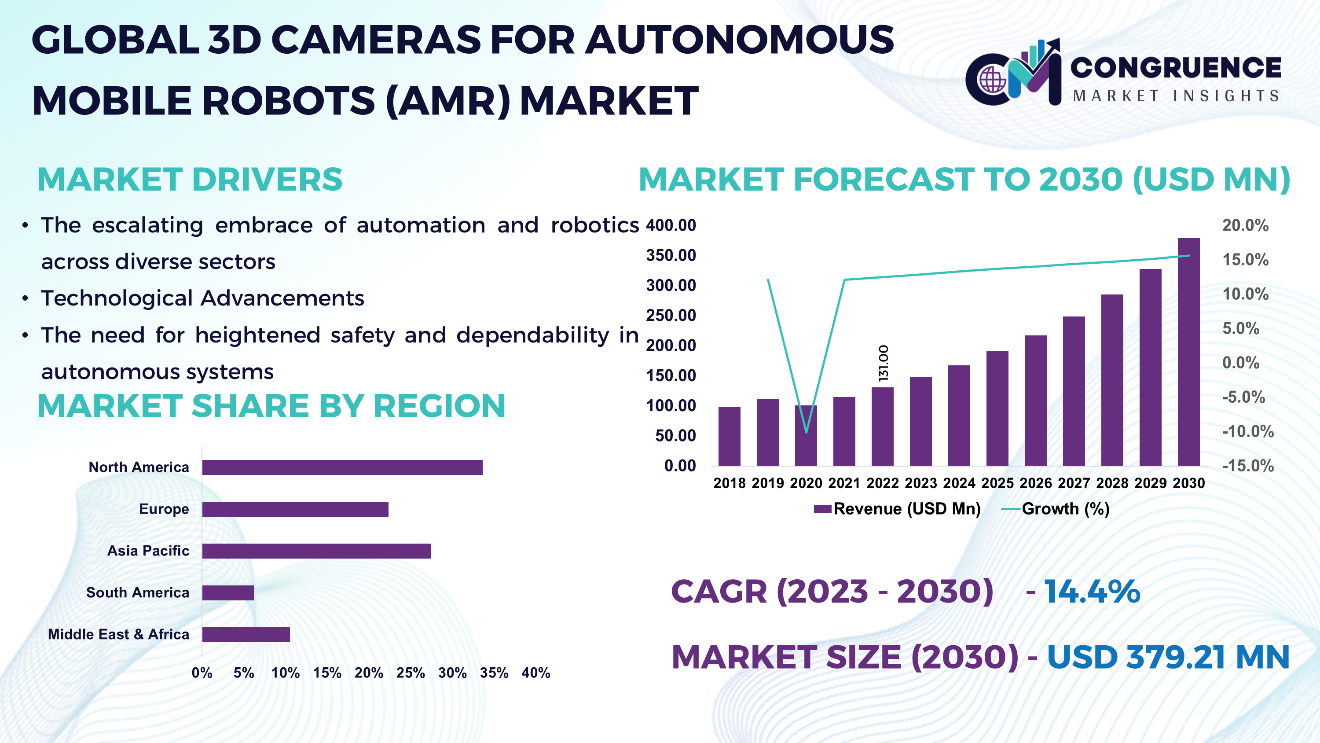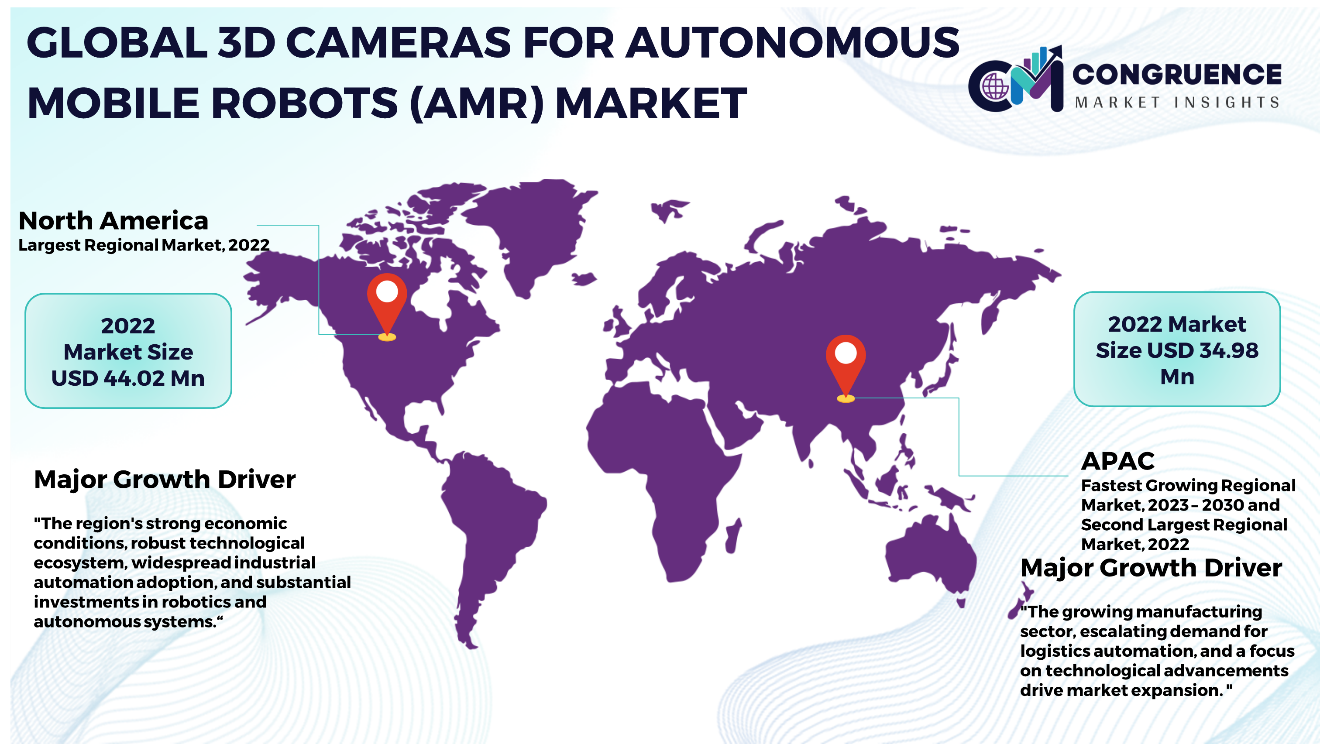Reports
The Global 3D Cameras for Autonomous Mobile Robots (AMR) Market was valued at USD 131 Million in 2022 and is anticipated to reach a value of USD 379.2 Million by 2030 expanding at a CAGR of 14.4% between 2023 and 2030.
In recent years, there has been a substantial surge in the global market for 3D cameras employed in Autonomous Mobile Robots (AMR), driven by the increasing adoption of automation and robotics across diverse industries. The significance of 3D cameras in enhancing the perceptual and navigational capabilities of AMRs is of paramount importance, facilitating their adept navigation through complex environments with heightened precision and efficiency. This market is characterized by a diverse array of participants, including established camera manufacturers, robotics enterprises, and technology innovators. Continuing advancements in sensor technologies, such as LiDAR and stereo vision, have played a pivotal role in elevating the performance of 3D cameras, reinforcing their integral role in the effective deployment of autonomous robots across sectors such as logistics, manufacturing, and healthcare. Furthermore, the escalating emphasis on safety and reliability in autonomous systems has spurred heightened investments in research and development, propelling the ongoing innovations in 3D camera technology tailored for AMRs.

3D Cameras for Autonomous Mobile Robots (AMR) Market Major Driving Forces
The escalating embrace of automation and robotics across diverse sectors: In the pursuit of heightened operational efficiency and productivity, the integration of AMRs equipped with sophisticated 3D cameras becomes imperative for effective navigation and perception in dynamic environments.
Technological Advancements: Advances in sensor technologies, especially in LiDAR and stereo vision, represent another substantial driving factor. These improvements enhance the performance and functionalities of 3D cameras, establishing them as essential components for the effective deployment of AMRs.
The need for heightened safety and dependability in autonomous systems: With a heightened focus on risk mitigation and ensuring secure operations, industries are increasingly inclined to invest in technologies that enhance the situational awareness and decision-making capabilities of AMRs. This trend is fueling a heightened demand for advanced 3D camera solutions.
3D Cameras for Autonomous Mobile Robots (AMR) Market Key Opportunities
Environmental Sustainability: The worldwide focus on sustainability creates possibilities for the advancement of energy-efficient and environmentally sustainable 3D camera technologies. Embracing eco-friendly practices can serve as a competitive edge in the market.
Expansion of AMR Applications: The increasing adoption of AMRs across various industries, including logistics, manufacturing, and healthcare, provides opportunities for the development of specialized 3D camera solutions tailored to specific industry needs.
Integration of Advanced Algorithms: The concentration on data analytics and artificial intelligence within the field of robotics presents a chance to integrate sophisticated algorithms with 3D camera systems. This integration empowers Autonomous Mobile Robots (AMRs) to enhance decision-making through real-time data, thereby increasing efficiency in dynamic environments.
3D Cameras for Autonomous Mobile Robots (AMR) Market Key Trends
· The ongoing development of 3D cameras with improved depth perception capabilities proves critical for AMRs, enabling effective navigation and interaction in complex and dynamic environments.
· An emerging trend involves integrating 3D cameras with other sensor modalities, such as LiDAR and radar, to form comprehensive sensor suites. This integration of multiple sensors enhances the overall perception and navigation capabilities of AMRs.
· Advanced algorithms and machine learning techniques empower 3D cameras to interpret and respond to visual data intelligently, thereby enhancing the adaptability and autonomy of AMRs.
· A rising trend is the customization of 3D camera solutions to meet diverse application needs in industries such as logistics, manufacturing, healthcare, and others. This reflects a growing acknowledgment of the varied requirements of AMRs.
Region-wise Market Insights
North America accounted for the largest market share at 33.6% in 2022 whereas, Asia Pacific is expected to register the second largest market share while generating revenue of more than USD 34.5 Million in 2022.

The global market for 3D cameras catering to Autonomous Mobile Robots (AMR) distinctly exhibits North America's pronounced dominance, ascribed to its robust technology ecosystem, widespread integration of industrial automation, and substantial investments in the development of robotics and autonomous systems. This preeminent position in the market is further accentuated by a mature regulatory environment that actively nurtures innovation. Concurrently, the Asia Pacific region emerges as the most rapidly advancing market, driven by the escalating adoption of automation in key economies such as China, Japan, and South Korea. This surge is fueled by a thriving manufacturing sector, increasing demand for logistics automation, and a concentrated emphasis on technological advancements. While these pivotal regions spearhead technological innovation and foster market expansion, other global regions, including Europe, South America, the Middle East, and Africa, contribute to the overall landscape with varying degrees of market penetration and growth rates. For the most current and nuanced insights into these market dynamics, prudent consideration should be given to consulting the latest market reports and industry analyses, given the dynamic nature of the robotics and automation sector.
Segment-wise Market Analysis
· Time-of-flight (ToF) Cameras tend to be the largest segment in the 3D Cameras for Autonomous Mobile Robots (AMR) market. ToF cameras provide real-time depth information by measuring the time it takes for light to travel to an object and back. This capability is crucial for AMRs to navigate and perceive their environment in real-time, and are expected to experience the fastest growth owing to its cost-effectiveness and ease of integration.
· Logistics and Warehousing dominate 3D Cameras for Autonomous Mobile Robots (AMR) representing the largest market segment, owing to precise navigation, inventory management, and safety, enhancing efficiency in picking, sorting, and automating operations in dynamic environments.
Market Competition Landscape
In the global market for 3D cameras tailored for Autonomous Mobile Robots (AMR), the competitive landscape is defined by a dynamic interaction among a diverse array of industry participants. Leading stakeholders include established camera manufacturers, robotics enterprises, and technological innovators, all actively striving for prominence in this swiftly expanding sector. Market leaders engage in strategic competition, consistently pursuing product innovation, employing strategic pricing approaches, and integrating advanced features to enhance the performance of 3D cameras designed for AMRs. The terrain also features emerging players introducing cutting-edge solutions, often challenging established norms and driving technological evolution. Collaborations and partnerships between companies are prevalent, fostering synergies and leveraging complementary strengths to gain a competitive advantage.
Crucial determinants of competitive positioning include the reliability and precision of 3D cameras, the ease of integration into existing AMR systems, and the cost-effectiveness of solutions. With the escalating demand for autonomous robotic systems across diverse industries, the global competition landscape in the 3D cameras for AMR market is expected to remain lively and dynamic, propelled by continuous advancements and evolving customer preferences.
Key players in the global 3D Cameras for Autonomous Mobile Robots (AMR) market employ various organic and inorganic strategies to strengthen and enhance their market positioning. Prominent players in the market include:
· SICK AG
· Intel Corporation
· FANUC
· KUKA AG
· OMRON Corporation
· Yaskawa Electric Corporation
· Fetch Robotics, Inc.
· Lumentum Operations LLC
· Velodyne Lidar, Inc. (Ouster Company)
· Mech-Mind Robotics Technologies Ltd.
· Zivid
· Cognex Corporation
· Terabee
|
Report Attribute/Metric |
Details |
|
Market Revenue in 2022 |
USD 131.0 Million |
|
Market Revenue in 2030 |
USD 379.2 Million |
|
CAGR (2023 – 2030) |
14.4% |
|
Base Year |
2022 |
|
Forecast Period |
2023 – 2030 |
|
Historical Data |
2018 to 2022 |
|
Forecast Unit |
Value (US$ Mn) |
|
Key Report Deliverable |
Revenue Forecast, Growth Trends, Market Dynamics, Segmental Overview, Regional and Country-wise Analysis, Competition Landscape |
|
Segments Covered |
· By Camera Type (Stereo Vision Cameras, Time-of-Flight (ToF) Cameras, and Structured Light Cameras) · By Application (Mapping, Object Detection and Recognition, Perimeter Security, Quality Inspection, and Others) · By End-User (E-Commerce and Retail, Logistics and Warehousing, Healthcare and Pharmaceutical, and Others) |
|
Geographies Covered |
North America: U.S., Canada and Mexico Europe: Germany, France, U.K., Italy, Spain, and Rest of Europe Asia Pacific: China, India, Japan, South Korea, Southeast Asia, and Rest of Asia Pacific South America: Brazil, Argentina, and Rest of Latin America Middle East & Africa: GCC Countries, South Africa, and Rest of Middle East & Africa |
|
Key Players Analyzed |
SICK AG, Intel Corporation, FANUC, KUKA AG, OMRON Corporation, Yaskawa Electric Corporation, Fetch Robotics, Inc., Lumentum Operations LLC, Velodyne Lidar, Inc. (Ouster Company), Mech-Mind Robotics Technologies Ltd., Zivid, Cognex Corporation, Terabee |
|
Customization & Pricing |
Available on Request (10% Customization is Free) |
